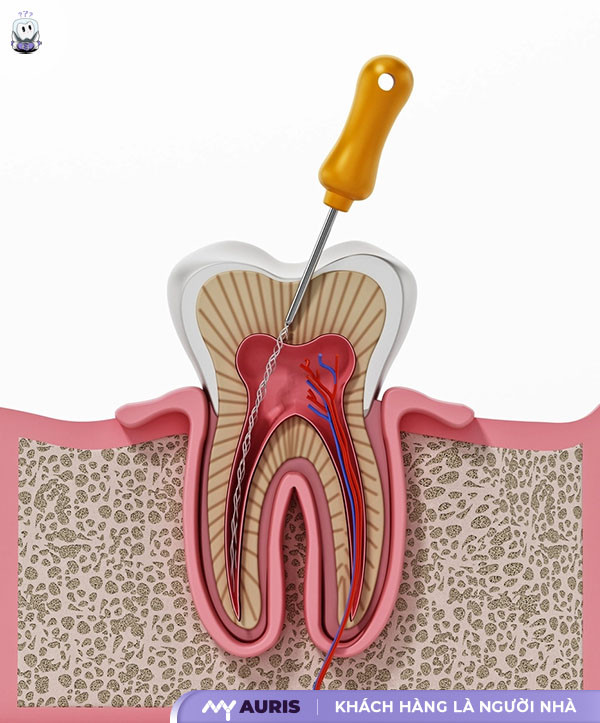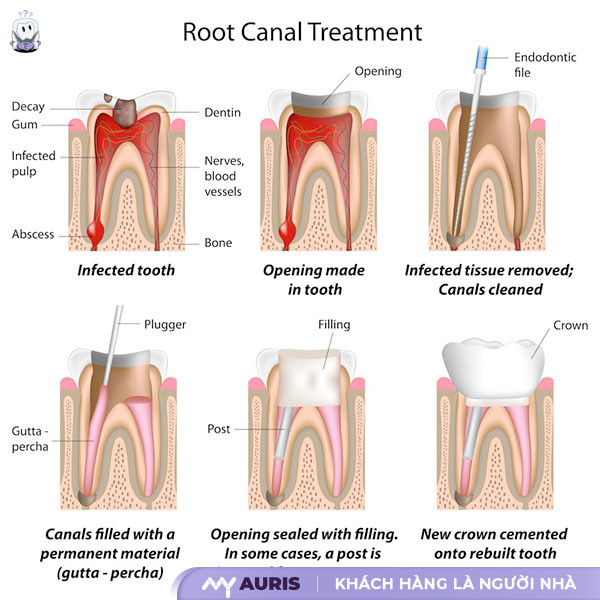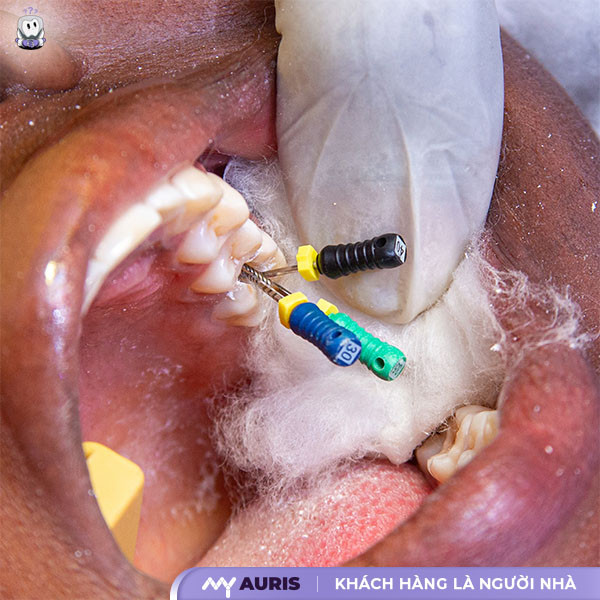Root canal treatment (endodontics) is a modern dental procedure that helps eliminate infection in the pulp chamber – the innermost core of the tooth containing nerves and blood vessels. With a specialized procedure performed by highly skilled dentists, this method is virtually painless and offers maximum preservation of the natural tooth. As a result, patients can maintain natural chewing function without needing extraction or replacement with artificial teeth. Early treatment is crucial as it helps prevent dangerous complications such as abscesses or jawbone loss.
What is Dental Pulp?
Dental pulp is a specialized connective tissue comprising blood vessels and nerves, located within the pulp cavity and surrounded by the hard tissues of the tooth, namely enamel and dentin. The blood vessels and nerves enter the pulp from the apex of the tooth root, also known as the root tip (apical foramen).
The pulp cavity is the space located in the center of the tooth, divided into two distinct parts. The crown portion contains the pulp chamber, where the pulp is located, known as coronal pulp. The root portion contains the root canals, where the pulp is located, known as radicular pulp. Each tooth root has one or more root canals along with several accessory canals, forming a complex root canal system that facilitates the transmission of blood vessels and nerves.
The sensory function of dental pulp helps the tooth perceive external stimuli. Furthermore, the dental pulp nourishes the tooth tissue and participates in dentin repair when damaged, contributing to the overall health of the tooth. Understanding the structure and role of dental pulp helps us protect our teeth more effectively and maintain comprehensive oral health.

What is Root Canal Treatment (RCT)?
Previously, teeth with pulp pathology often had to be extracted due to a lack of effective treatment methods. However, with modern techniques, root canal treatment helps save the tooth, prevent future complications, and protect it for long-term durability. Understanding the root canal treatment process not only brings peace of mind to patients but is also an important step in comprehensive oral healthcare.
How Long Does Root Canal Treatment Take?
How long root canal treatment takes depends on various factors, especially the extent and condition of the tooth requiring treatment. For cases of infected dental pulp, patients typically need 3-4 treatment sessions to achieve optimal results. In contrast, for teeth with exposed but uninfected pulp, root canal treatment only takes about 1-2 sessions. Additionally, the treatment duration varies depending on the tooth area; specifically, single-rooted teeth will have a shorter treatment time compared to multi-rooted teeth, such as molars. Understanding these factors helps patients better prepare and ensures the root canal treatment process is effective and safe.

Protocol for Deciduous (Baby) Tooth Root Canal Treatment
The protocol for deciduous (baby) tooth root canal treatment at My Auris dental clinic utilizes advanced technology with a specific, precise treatment process to deliver optimal results for children.
The first step in the deciduous tooth root canal treatment protocol is a thorough general examination, including X-rays of the suspected inflamed pulp area. This allows the dentist to precisely determine the extent of inflammation and the shape of the root canals, providing a comprehensive overview to assess the case’s complexity and plan appropriate treatment.
Before beginning, a meticulous oral hygiene procedure is performed to ensure the child’s mouth is clean. Next, local anesthesia is administered in a modern sterile environment, ensuring the child is comfortable, pain-free, and cooperates well with the dentist throughout the treatment.
A rubber dam will be precisely placed on the tooth requiring root canal treatment to isolate it from the gums and oral cavity. This prevents root canal medication from entering the child’s digestive or respiratory tracts, ensuring absolute safety.
The root canal treatment proceeds with the use of a specialized drill to clean the root canals. Afterward, the dentist will seal the root canal system and permanently fill the cavity surface with a specialized restorative material to preserve the tooth and ensure the treatment’s longevity.
Finally, My Auris dental clinic will provide detailed advice on scientific oral hygiene for children and schedule regular follow-up appointments to help maintain long-term and effective treatment results.
The deciduous tooth root canal treatment protocol at My Auris dental clinic is not only based on deep professional expertise but also utilizes advanced technology, providing peace of mind and satisfaction for parents and pediatric patients.
Root Canal Treatment is Often Performed Over Multiple Sessions
Preparing for Root Canal Treatment
Before beginning root canal treatment, the dentist will take an X-ray of the infected tooth to accurately assess the root canal system and the extent of the damage. This provides the dentist with a comprehensive view to plan appropriate treatment.
The treatment process usually involves local anesthesia to minimize pain for the patient, especially in the inflamed decayed tooth area and surrounding gums. However, in cases where the patient has already lost sensation in the decayed tooth, local anesthesia may not be necessary.
Removing Necrotic Pulp Tissue
The dentist will place absorbent gauze around the decayed tooth to ensure dryness throughout the treatment and prevent the patient from swallowing chemicals used during the procedure. Next, the dentist drills an access opening into the pulp chamber at the center of the tooth, then uses specialized instruments to remove the necrotic pulp tissue. If there is swelling, pus, or an abscess, the pus will also be drained.
Cleaning and Filling the Root Canal
After removing the dead pulp, the dentist cleans and fills the root canals. Since root canals are very narrow and difficult to seal, small files are used to widen the canal pathways and reshape them to their normal form, preparing them for obturation. This process often takes hours and is divided into multiple sessions.
Incisors and canines typically have only one root canal per root, whereas premolars and molars have 2 to 3 roots, each containing 1 or 2 canals, making the treatment process for these teeth more time-consuming. During prolonged treatment sessions, the dentist may place medication into the cleaned root canal to eliminate bacteria and apply a temporary filling. If the patient develops symptoms of infection such as fever or gum swelling, antibiotics will be prescribed.
Filling and Restoring the Tooth
At the next appointment, the temporary filling and medication will be removed and replaced with a permanent filling to seal and encase the root canals, preventing reinfection. However, filled teeth are often more susceptible to damage than natural, untreated teeth. Therefore, dentists often recommend patients get a dental crown to protect the tooth.
Some filled teeth may darken in color due to dead pulp or strong forces. To remedy this, professional teeth whitening using specialized chemical agents can be applied.
Placing a Crown on the Tooth
A dental crown is a cap that covers the tooth’s surface, protecting a root-canal-treated tooth and preventing the risk of fractures. Crowns are typically made of metal, porcelain, ceramic materials, or glass ceramics. Before placing the crown, the dentist will reduce the tooth’s size and take precise impressions to ensure a snug fit. An adhesive is used to strengthen the bond between the crown and the tooth. If the tooth has been extensively modified after treatment, a post may be inserted into the root canal to secure the crown in position, ensuring long-term protective effectiveness.

Success Rate of Root Canal Treatment
Root canal treatment has a high success rate in preserving natural teeth and thoroughly cleaning the infected parts within the root canals. Statistics show that approximately 9 out of 10 teeth that undergo root canal treatment can remain stable for 8 to 10 years. Notably, for teeth that are crowned after treatment, the stability and lifespan of the tooth are significantly enhanced.
The tooth will become stronger if the patient maintains proper oral hygiene and a diligent care routine. Furthermore, the lifespan of a tooth after root canal treatment also depends on factors such as the remaining natural tooth structure after the procedure (as the tooth is often drilled and shaped during treatment), the level of oral hygiene, and the intensity of daily tooth use by the patient.
Should the infection recur, retreatment of the root canal may still be considered to preserve the tooth. If the tooth remains infected after initial treatment, the dentist may recommend a minor surgical procedure, specifically an apicoectomy (root-end resection), to definitively resolve the infection and comprehensively protect oral health.
Recovery After Root Canal Treatment
Post-root canal treatment care is crucial for a smooth recovery process. During this period, patients should avoid hard foods until the treatment process is complete, to protect the tooth from further damage. While the tooth usually no longer causes pain after root canal treatment, a slight feeling of discomfort or tenderness may persist for the first few days.
To alleviate post-treatment discomfort, patients can take pain relievers or anti-inflammatory drugs suchs as paracetamol and ibuprofen as directed by their dentist. If pain or swelling persists after taking pain medication, patients should return to the dental clinic for a thorough check-up and prompt treatment.
Furthermore, to prevent future recurrence of oral infections, proper oral hygiene is essential. Additionally, limiting excessive sugary foods and quitting smoking habits also contribute to maintaining stable oral health after treatment.





